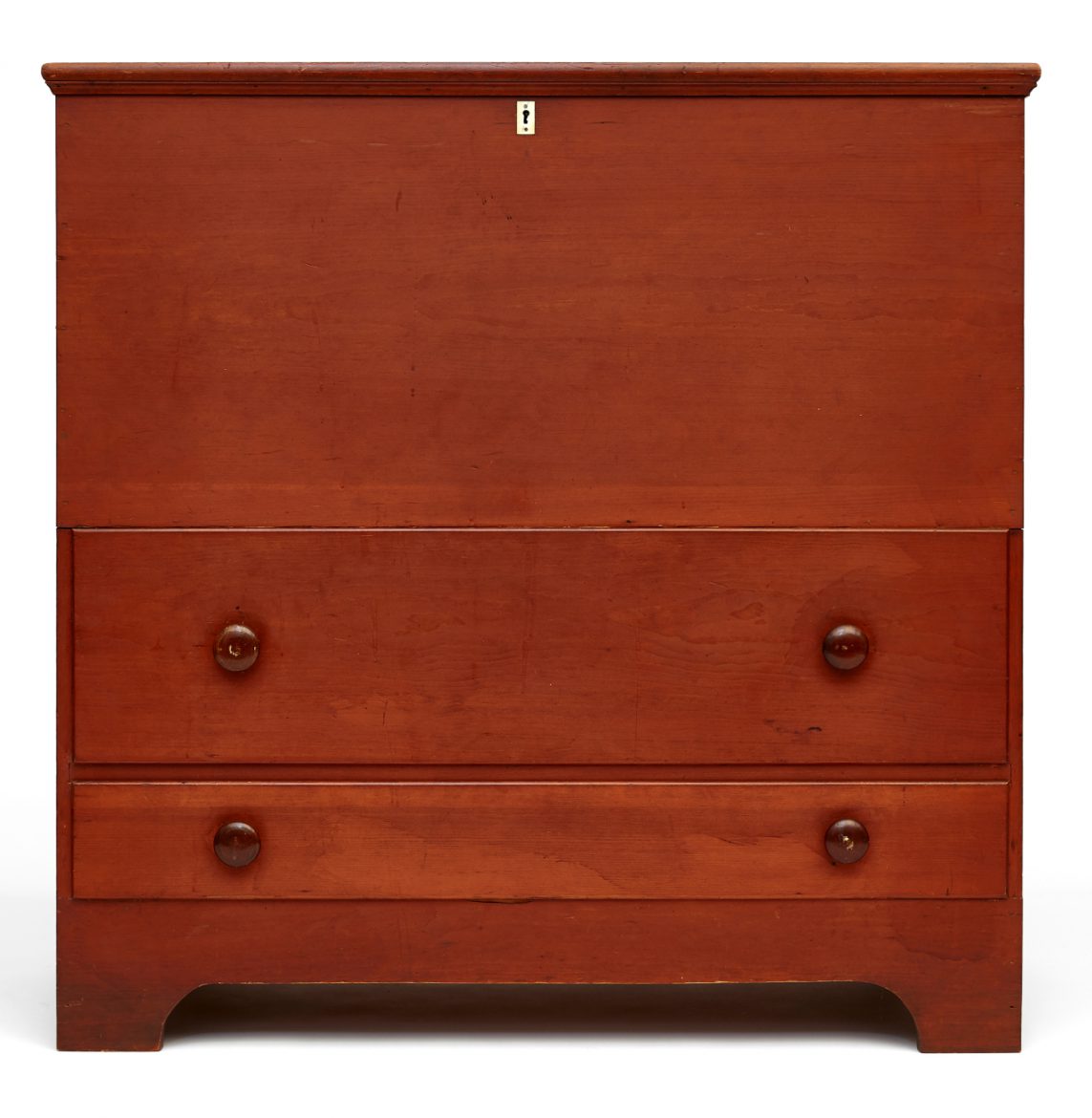
In June 2001 the antique firm Courcier and Wilkins of Yarmouth Port, Massachusetts purchased a red painted two-drawer blanket chest. The piece had suffered moisture damage to several of its feet and, in hopes of salvaging the piece for resale, Courcier and Wilkins made arrangements to have the feet restored. When the cabinetmaker doing the […]

Blanket Chest, North Family, Mount Lebanon, NY, 1866. Shaker Museum | Mount Lebanon 2003.1.1 Photo by Alan Lavallee.
In June 2001 the antique firm Courcier and Wilkins of Yarmouth Port, Massachusetts purchased a red painted two-drawer blanket chest. The piece had suffered moisture damage to several of its feet and, in hopes of salvaging the piece for resale, Courcier and Wilkins made arrangements to have the feet restored. When the cabinetmaker doing the restoration turned the piece upside down to work on the feet, he found an inscription written on the bottom of the drawer slide supporting the upper drawer. The inscription read:
“1866 Richard Bushnell Maker North Family Shaker Village Mt Lebanon N.Y. The first chest he ever made being no carpenter or joiner and now in the seventy-six year of his age – 1866.”

Blanket Chest (detail of inscription), North Family, Mount Lebanon, NY, 1866. Shaker Museum | Mount Lebanon 2003.1.1. Photo by Robert Wilkins.
Although no carpenter or joiner, Elder Richard (1791-1873) certainly did a fine job at being one. The chest is well made and very much in the tradition of similar pieces made at Mount Lebanon. The Shaker Museum, at that time in negotiations to acquire the North Family property, understood how important this particular piece would be in telling the story of that family and particularly of one of its most important members.
Richard Bushnell was born in Saybrook, Connecticut on November 19, 1791. He moved to New York City and learned the trade of making horn combs. When finished with his apprenticeship he set out toward Utica, New York to find a farm and a circumstance for himself. His travels brought him to New Lebanon, where he lodged for the night at a local hotel. He asked who lived in the beautiful hamlet he could see on the hillside. The hotel-keeper cautioned him about the “fanatical followers of Ann Lee,” but the curious twenty-two-year-old ignored her warning and went the next day to see for himself. The village impressed him with its order, cleanliness, and quiet – “there were no dogs, no loafers, no drinking saloons.” Elder Calvin Green noticed the “serious and thoughtful” young man at the public meeting and later investigating the grounds of the village. He invited him to rest and become acquainted with the Shaker faith.

“Group of Shakers (detail),” Stereograph, North Family, Mount Lebanon, NY, ca. 1871. Shaker Museum | Mount Lebanon 1953.6118.1. Photo by James Irving. Elder Richard Bushnell is the man sitting in front of the fence with his hat on his knee.
Richard’s visit shaped the rest of his life. He quickly accepted the Shaker faith, put his business affairs in order, and in 1813 became a Shaker. As a Shaker Brother Richard was quickly identified as a strong force in the North Family. In 1821 he was appointed the family Trustee and six year later the Second Elder under Calvin Green, whom he replaced in 1832. Bushnell was known for his strong leadership, his frugal care of the family’s resources, and his hard work. In 1850, he set out 1,200 locust trees in “the Grove” for the Shakers to harvest as fence posts to use and to sell. Many of the locust trees still growing in the North Family are volunteers from Elder Richard’s first crop. In 1858 Bushnell resigned his Eldership at the North Family to stand as the Second Elder in the Lebanon Ministry, but “due to a nervous disorder” he never took up residence at the Church Family. He was apparently resistant to assume his new role in the Ministry and it was eventually decided he would remain at the North Family and take up making seed boxes. In 1861, working at the North Family Saw Mill, he cut off some fingers with the buzz saw, but apparently continued to be able to work with wood as evidenced by the blanket chest featured here.
Eldress Anna White wrote of Elder Richard Bushnell that he “was a spiritual father of the purest and holiest type, beloved by his family and held in highest confidence and esteem in the whole region where his life was spent,” and Elder Frederick Evans, who succeeded Bushnell as the North Family Elder, wrote, “A brother who I esteem as one of the best men now living upon the earth.”